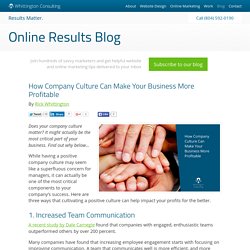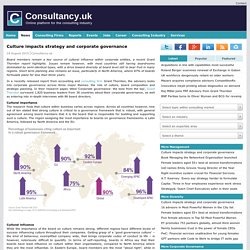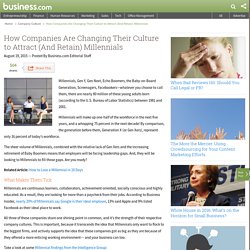

64% feel culture crafting comes from the C-Suite: Full infographic here > #organizationalculture #brand. Four Tips: Building Trust and Credibility by Stacy Lindenberg. “The recognition you and your team receive will build trust and credibility in and beyond your organization.”

A friend of mine had a problem. Notice that it really wasn’t me. It was a friend. I swear. This person has experience, leadership skills, integrity, and know-how. Regardless of his expertise, experience, or credibility, something stood in his way. Sound familiar? #1: Avoid the island Remember the movie Castaway with Tom Hanks?
Ever feel like that in your organization? You’re busy struggling to survive. How did you arrive at this island? Without the entire crew in place to support you, you are left to work things out on your own. You need a support team, a back-up plan, and buy-in. Wilson is not enough. #2: Build partnerships Think about a time that you worked with someone who made you think. After spending time with them, you were still pondering about questions they asked, what you answered, and what it all meant. That person demonstrated “organized curiosity.” What if you can’t help? Guiding Star - Survey on Microculture for Culture Digs.
Do retreats have a place in corporate culture? Early in my career I was part of a team responsible for putting on an annual employee event.

It was huge; thousands of employees from around the United States attended. Our team was small and the workload—especially during the week of the event—was overwhelming. A few weeks after the event, our senior leader invited us to her house for an afternoon meeting to debrief the event. We were a bit wary, and after months of working overtime, we were weary as well. When we arrived for the meeting we found that (along with her assistant’s help) this senior leader had converted her house into a day spa. That was more than 15 years ago, but recently in my Facebook feed, as well as in the New York Times, I’ve read about businesses that are once again taking groups of employees on retreats. When you take employees out of their normal environment, great things happen.
Don't let your corporate culture just drift along to nowhere. Shape… Mixed up company values explain many corporate troubles. #workplac… 15 Questions to Help You Decode Company Culture and Politics. My favorite definition of culture is “the way things get done around here.”

Years ago when I worked at Microsoft, my cousin, who was a private investigator in DC, came out for the holidays. He asked how we could really be serious and get work done while wearing a fleece and sneakers. I told him we worked long and hard, and therefore had to be as comfortable as possible: Didn’t he find wearing a suit a distraction? How Company Culture Can Make Your Business More Profitable. By Rick Whittington inShare7 Does your company culture matter?

It might actually be the most critical part of your business. Find out why below… How Better Internal Communications Can Triple Productivity. Have you ever wondered how your company could benefit if all of your employees were engaged and enthusiastic about their work?

A study by Dale Carnegie finds that companies with engaged employees "outperform those without by up to 202 percent. " One highly effective way to engage employees is to establish an internal communications plan. Towers Watson reveals that "companies with highly effective communication practices enjoy 47 percent higher total returns to shareholders compared with the firms that are least effective at communicating. " Now we’re talking. As a business owner, much of your hard-pressed time is devoted to researching, evaluating, and manipulating how customers perceive your company.
And the payoff can be tremendous. Culture impacts strategy and corporate governance. Board members remain a key source of cultural influence within corporate entities, a recent Grant Thornton report highlights.

Issues remain however, with most countries still having boardrooms dominated by semi-identical types, with a drive toward diversity at board level still to bear fruit in many regions. Short term planning also remains an issue, particularly in North America, where 87% of boards formulate plans for less than three years. Changing Culture to Attract Millennials.
Millennials, Gen Y, Gen Next, Echo Boomers, the Baby-on-Board Generation, Screenagers, Facebookers—whatever you choose to call them, there are nearly 80 million of these young adults born (according to the U.S.

Bureau of Labor Statistics) between 1981 and 2001. Millennials will make up one-half of the workforce in the next five years, and a whopping 75 percent in the next decade! By comparison, the generation before them, Generation X (or Gen Xers), represent only 16 percent of today’s workforce. The sheer volume of Millennials, combined with the relative lack of Gen Xers and the increasing retirement of Baby Boomers means that employers will be facing leadership gaps. And, they will be looking to Millennials to fill those gaps.
Changing Culture to Attract Millennials. Charles O’Reilly: Finding a Corporate Culture that Drives Growth. Corporate leaders and academics have been debating the connection between institutional culture and growth for more than three decades.

Charles O'Reilly: Finding a Corporate Culture that Drives Growth. Organizational Culture Survey - Guiding Star. Todd sur Twitter : "Culture Dig daily - We have found the top articles on company culture for you. #organizati... Culture Dig. 10 Signs a Company Has a Serious Culture Problem. Pay Attention: 3 Corporate Culture Shaping Techniques. Tim Wright On May 19, 2014 Employee Engagement (defn.): employee’s investment of time, energy, creativity, knowledge, skills and abilities to fulfill expectations of work assigned.

Business/Corporate Culture (defn.): the philosophy, values, behavior, dress codes, etc., that together constitute the unique style and policies of a company. The above phrases are defined numerous ways by numerous sources. The above definitions include the factors that comprise Employee Engagement and Business/Corporate Culture. You Can’t Dictate Culture — but You Can Influence It. There’s an old joke about a CEO who attended a presentation on corporate culture and then asked his head of HR to “get me one of those things.”

Of course it sounds ludicrous — but like most jokes, this story is based in truth. Many organizations treat the creation, maintenance, and periodic updating of their cultures in a cavalier manner. Either they pay lip service to the kind of culture they want, but don’t do much about it — or worse, ignore culture completely. Top 5+ key elements in shaping company culture. Many leaders spend a lot of time talking about company culture: What does it take to create the right kind of culture? How can you maintain that culture? How to build an organization that is fit for the future?
But still many organizations treat the creation, maintenance, and periodic updating of their cultures in a cavalier manner. There’s an old joke about a CEO who attended a presentation on change management and corporate culture and then asked his head of HR to: Culture shaping. Every company has its own unique culture, defined by a collective set of values and habits that condition actions of people within the organization. Culture is essentially the written and unwritten rules of how people work with each other, customers and other stakeholders.
Cultures become ingrained over time as a response to the style and actions of an influential leader. An organization's culture plays a significant role in its ability to successfully execute strategic plans. Successful leaders shape their cultures instead of allowing their cultures to shape the company. Watch video with Senn Delaney President and CEO Jim Hart on why cultures need to be shaped. Company Culture Initiatives: 5 Bottom-Line Reasons To Rebuild Your Corporate Culture Now. 4 Ways Every Employee Can Help Build Positive Corporate Culture. In the high-pressure world where many people work, executives, managers and employees sometimes fail to focus on how to improve corporate culture, which often takes a back seat to a focus on billable hours and producing profits. Bruce Madnick, managing partner of top-50 accounting firm Friedman LLP, believes a positive work culture is key and thinks everyone can contribute to it.
If you’re interested in helping create a positive, sharing and transparent culture, here are Madnick’s top tips to stand out in the crowd: 1. Be quick to share credit when something goes well. Have you heard the quote: “Leaders take all the blame and give away all the credit”? Innovation and Corporate Culture. How To Create A Culture Of Productivity. As the CEO of a startup, I’ve realized how important it is to increase productivity while at the same time limiting expenses as much as possible. But this can be difficult to do and at times seems impossible.
While waving a magic productivity wand would be much easier and ideal, the magic is not really possible if the right culture or productive work habits are not in place. That’s why it’s important to create a culture where productivity is celebrated starting with the first hire. The tempo a business owner/entrepreneur sets for their company’s culture will be hard to maneuver onto a different path once established, so here are five ways I have been able to create a culture of productivity: 1.
Who you hire makes all the difference, but it’s not all about what’s on their resume, especially not at a startup. All of these desired characteristics add up to someone who will want to work hard every day and takes pride in getting things done! 2. 3. 4. Values & Visuals In Business Culture. The Premier Workplace Culture Educational Site where the top workplace culture experts in the world share their insights.
Myemail.constantcontact.com/Are-you-too-scared-to-initiate-a-corporate-culture-survey-.html?soid=1115608122678&aid=UuVaf0RNx-4. It's October and kids all around the world are gearing up for a scary Halloween season. But being scared isn't reserved just for Halloween. There are many situations at home and in the workplace that can provoke a sense of fear. For example, choosing to assess your culture can be a scary proposition. If the culture of the organization is set by the leaders, then a cultural assessment becomes an assessment of them. Use These 14 Questions for a Corporate Culture Audit.
Roadblocks to a Customer-Focused Culture. Popular Today in Business: All Popular Articles Customer Experience By Lisa Ford, Published August 23, 2014. How To Create A Culture of Innovation. There are many pieces to the innovation puzzle, and they will come together differently for each organization. How one goes about building an innovative organization ought to be unique. But for every organization, it starts with the right mindset--the unexpected must be expected. Who would have thought that cell phones would become cameras and music players? Changing Culture: Scaling Up Excellence. I’ve found myself picking up books about how to change culture, as it seems to be the big barrier to a successful revolution. I’ve finished a quick read of Scaling Up Excellence, am in the midst of Change the Culture, Change the Game, and have Reinventing Organizations and Organize for Complexity (the latter two recommended by my colleague Harold Jarche) on deck.
The Cultural Web - Strategy Tools from MindTools.com. Deal and Kennedy's Cultural Model - from MindTools.com. Managing the Library's Corporate Culture for Organizational Efficiency, Productivity and Enhanced Service, Samuel Olu Adeyoyin. FULLTEXT01. What Is Corporate Culture? Best Business Books 2014: Organizational Culture. Richard Sheridan Joy, Inc.: How We Built a Workplace People Love (Portfolio/Penguin, 2013) Malachi O’Connor and Barry Dornfeld The Moment You Can’t Ignore: When Big Trouble Leads to a Great Future (PublicAffairs, 2014) Dave Eggers The Circle (Knopf, 2013) Increasingly, business consultants, scholars, and executives are coming to the conclusion that culture is the prime driver of organizational performance.
Despite the prevalence of that point of view, however, there’s little agreement about what culture is or what it entails. You can’t see it, touch it, or measure it, yet culture is said to explain why some companies fare better than others. 10 Reasons to Design a Better Corporate Culture. By James L. Heskett, W. Earl Sasser, and Joe Wheeler. 9 Types of Organizational Culture: Which One Are You? Culture: Why It's The Hottest Topic In Business Today. CultureTalks Videos. Turn Your Company Culture From "I" to "We" Desk.com. Company Culture Drives Successful Companies. 3 Principles for a Contagiously Engaging Company Culture. The Art of Building A Strong Culture. Shaping Corporate Culture. Welcome to Inc.com. Hire for Organizational Culture Fit First, Skills Second: 5 Steps to Achieve That. Group Dynamics and Organizational Culture: Effective Work Groups and ... - Athena Xenikou, Adrian Furnham.
Eight Traits of a Healthy Organizational Culture (fostering a sharp customer focus) How To Create The Best Organizational Culture. The 12 Attributes of a Strong Organizational Culture. 25 Best Corporate Cultures. Organizational culture has reached a tipping point, yet many culture change initiatives fail for four key reasons. The HubSpot Culture Code: Creating a Company We Love. 4 ways to enhance company culture at your agency through digital (page 5 of 5)
Key principles of culture shaping. How does a CEO of a startup build a successful corporate culture? Operating Partner, DFJ. 12 Signs Your Company Has An Enviable Workplace Culture. Spend Time on Corporate Culture. Workplace Culture: the Good, the Bad, and the Amazon Effect.